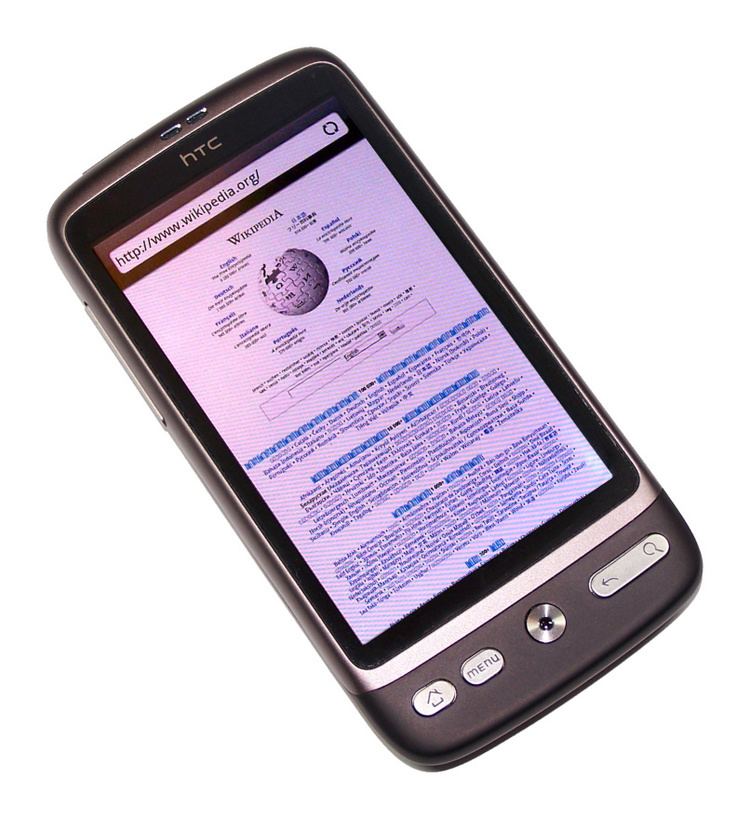Codename Bravo | ||
 | ||
Compatible networks Europe/Asia Pacific: HSPA/WCDMA900/2100 MHz [Model A8181]850/1900 (Telus Mobility Canada) [Model A8182]850/2100 MHz (Telstra Australia) [Model A8183]GSM 850/900/1800/1900 MHz First released 16 February 2010; 7 years ago (2010-02-16) Availability by country South Korea May 2010 (2010-05) | ||
The HTC Desire (codenamed Bravo) is the first smartphone of the Desire series developed by HTC. It was announced on 16 February 2010 and released in Europe and Australia in the second quarter of the same year. The HTC Desire was HTC's third flagship phone running Android, 2.1 Eclair which can be upgraded to 2.2 Froyo or 2.3 Gingerbread. Internally it bears a strong resemblance to the Nexus One, but differs in some features.
Contents
Availability
In the United States, the device was available from Alltel, U.S. Cellular, Cellular South, Cox Wireless, nTelos Wireless, Cellcom, and United Wireless in southwest Kansas. In Canada, the device was released by Telus Mobility on 6 August 2010.
In Europe, the carriers were Elisa in Finland, Vodafone UK, Vodafone Ireland, Meteor Irl, BT Broadband Anywhere, T-Mobile UK, O2, Orange UK, 3, and Virgin Mobile UK. In Australia, it is exclusive to Telstra. In Japan, Softbank Mobile started sales in April. In Turkey, Vodafone started sales in late November 2010.
In South Korea, SK Telecom began sales in May 2010.
In Singapore, the official launch date was 14 May 2010, and the phone was subsequently for sale by all carriers.
In mainland China, HTC launched its four flagship smartphones including the Desire on 27 July 2010. Unlike in other markets, the device was shipped with Android 2.2 ("Froyo").
Many of the UK mobile networks were unable to keep up with demand; Virgin Mobile UK, Vodafone UK, 3, T-Mobile UK and Orange UK experienced very high demand. The ash produced by the 2010 eruptions of Eyjafjallajökull led to some customers waiting a month getting their HTC Desires due to much of European airspace being closed.
In India, HTC and TATA DOCOMO, the GSM brand of Tata Teleservices Limited, announced a partnership to launch HTC Desire in India on 16 August 2010.
Hardware
The phone uses a 1 GHz ARMv7 "Snapdragon" processor, includes a 5 megapixel auto-focus camera and an optical trackpad, and was among the first consumer devices to feature a large, full-color active-matrix OLED (AMOLED) display.
During late Q2 2010, HTC made the decision to switch the Desire's display to a S-LCD panel, manufactured by the company S-LCD a co-operative between Sony and Samsung. Although this was brought on by a severe AMOLED panel supply shortfall, the new display greatly enhances text readability because of its improved effective resolution, one of the few complaints people had with the original Desire model. Compared to the original AMOLED display, the SLCD display has more accurate colour reproduction, far less susceptibility to burn-in, similar peak brightness and very good viewing angles, but a lower contrast ratio. The new SLCD display was claimed to have similar or better power efficiency compared with the original AMOLED display; however, this has proved to not always be the case because with AMOLED pixels' ability to completely turn off, black or dark pixels use very little power. However, in situations when the screen is predominantly bright (such as when viewing many web pages), the AMOLED display uses more power.
The hardware is capable of high-definition (720p) video recording and playback; the 720p video recording feature has been added to the HTC Desire when updating to the official HTC modified Android 2.2 firmware.
Software
The Desire was shipped with Android 2.1. HTC made an update to Android 2.2 (codenamed "Froyo") available on the following dates:
HTC has released a software update to upgrade the Desire to Android 2.3 (Gingerbread). Originally, they planned to do this in June 2011. On 14 June 2011, HTC announced via Facebook that there would be no Gingerbread update for the HTC Desire, citing memory constraints. This is because HTC had been unable to fit both Gingerbread and HTC Sense together in the phone's 250 MB system partition. However, on 15 June, they released a statement saying the Desire would receive the Gingerbread update, with the possibility of some apps being cut. The update was finally released for download from HTC's developer website on 1 August 2011, and is not available as an OTA (over-the-air) update.
Comparison with Nexus One
The Desire internally bears a strong resemblance to the Nexus One. The differences found in the Desire are:
Because of the strong similarity to the Nexus One "developer phone", the Desire enjoys a highly active third-party developer community. The Desire subforum was one of the most active at xda-developers, and notably CyanogenMod and MIUI are available for the device.
Reception
The HTC Desire received extremely positive reviews. CNET UK reviewed awarded the phone 9.2/10. TechRadar awarded the phone 5 out of 5 stars and stated, "In short, this is a phenomenal phone—one of the best we've ever had."
From TechRadar's 'Top 15 best mobile phones in the world', the HTC Desire is simply the best so far: "It's like a Nexus One only better. For this reason, the HTC Desire has entered our top 10 at number 1, and the Google Nexus One has dropped out completely. It's tough at the top." MobileTechWorld found the HTC Desire to be a fairly capable product that "manages to please casual users with HTC’s flashy Sense UI and geeks who love to tweak their handsets on a daily basis thanks to the Google’s Android OS."
